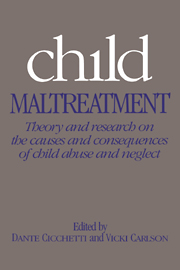Book contents
- Frontmatter
- Contents
- List of contributors
- Preface
- Part I History and definition
- Part II Parental and contextual influences on maltreatment
- 6 Lessons from child abuse: the determinants of parenting
- 7 The antecedents of maltreatment: results of the Mother–Child Interaction Research Project
- 8 Parental attributions as moderators of affective communication to children at risk for physical abuse
- 9 Perceived similarities and disagreements about childrearing practices in abusive and nonabusive families: intergenerational and concurrent family processes
- 10 Cognitive foundations for parental care
- 11 Intergenerational continuities and discontinuities in serious parenting difficulties
- 12 The construct of empathy and the phenomenon of physical maltreatment of children
- Part III The developmental consequences of child maltreatment
- Name index
- Subject index
9 - Perceived similarities and disagreements about childrearing practices in abusive and nonabusive families: intergenerational and concurrent family processes
Published online by Cambridge University Press: 04 May 2010
- Frontmatter
- Contents
- List of contributors
- Preface
- Part I History and definition
- Part II Parental and contextual influences on maltreatment
- 6 Lessons from child abuse: the determinants of parenting
- 7 The antecedents of maltreatment: results of the Mother–Child Interaction Research Project
- 8 Parental attributions as moderators of affective communication to children at risk for physical abuse
- 9 Perceived similarities and disagreements about childrearing practices in abusive and nonabusive families: intergenerational and concurrent family processes
- 10 Cognitive foundations for parental care
- 11 Intergenerational continuities and discontinuities in serious parenting difficulties
- 12 The construct of empathy and the phenomenon of physical maltreatment of children
- Part III The developmental consequences of child maltreatment
- Name index
- Subject index
Summary
Physical abuse of a child occurs within a family context and yet little is known about many of the processes that may differentiate abusive families from nonabusive families. The evidence that does exist indicates that abusive families differ from nonabusive families in the quality of parent-child interactions (Burgess and Conger, 1978; Reid, 1986; Trickett and Kuczynski, 1986), in parental attitudes and values about childrearing, and in parental perceptions of their children (Susman, Trickett, Iannotti, Hollenbeck, and Waxier, 1985; Trickett, Susman, and Gordon, 1984). However, to understand child development within the context of the family, one must go beyond looking solely at parent-child dyadic interaction to examine other aspects of complex family processes (see, e.g., Bronfenbrenner, 1977).
It is the purpose of this chapter to examine two aspects of family process of particular relevance to the etiology of abuse and to the consequences of abuse for child development. These two areas are: first, parents’ perceptions of their own upbringing – a topic that bears on the issue of intergenerational transmission of abuse – and second, parental conflict or disagreement, especially concerning childrearing.
Parental perceptions of their own upbringing
The notion of intergenerational transmission is popularly posited as an important factor in the etiology of child abuse. There is, in fact, considerable empirical evidence that abusive parents are more likely to have experienced aggression, violence, and/or harsh physical punishment during their childhood than nonabusive parents (Parke and Collmer, 1975), although it is also clear that many people with similar backgrounds do not become abusive parents (Cicchetti and Rizley, 1981).
- Type
- Chapter
- Information
- Child MaltreatmentTheory and Research on the Causes and Consequences of Child Abuse and Neglect, pp. 280 - 301Publisher: Cambridge University PressPrint publication year: 1989
- 11
- Cited by

